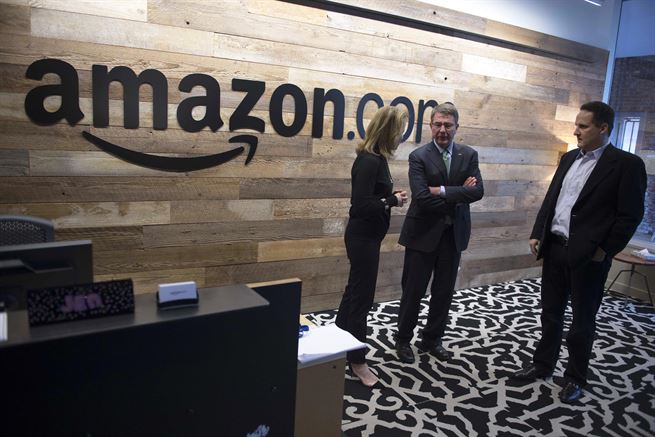Author by: Paris Marx
Black Friday is synonymous with the image of consumers storming big box stores, but a growing number of shoppers are opting instead to stay home and get their deals from Amazon. In 2017, so many people chose to do so that as thousands of digital carts were being checked out, the wealth of Amazon CEO Jeff Bezos hit a new milestone: $100 billion.
$100,000,000,000
There are eleven zeroes after the one, which is more than the nominal GDP of Ecuador, and the figure was driven by the boost in Amazon stock when early Black Friday sales numbers were announced. It’s estimated the e-commerce giant took half of all online spending on Black Friday, while Cyber Monday was its biggest shopping day of all time.
Given that Amazon is the fourth largest publicly traded company in the world with a market cap expected to hit a $1 trillion in 2018, it’s worth considering who is responsible for generating all that wealth. There’s no question that Bezos himself deserves credit for turning an online bookstore into a juggernaut that has expanded into numerous product categories, bought up plenty of its competitors, established a massive fulfillment network, built an $18 billion cloud computing business, has made a big push into the grocery market with the purchase of Whole Foods, and has gotten so large that lawmakers are considering antitrust action.
But the credit for Amazon’s success cannot go solely to Bezos. As the second largest private employer in the United States, there are a lot of workers making important contributions. However, many of the people who are essential to delivering on the promise of great prices, reliability, and speedy delivery that Amazon’s brand is built on aren’t even included in that number. They’re independent contractors and seasonal workers who get paid little, but without whom the company would be lost. And they likely make less in a year than the estimated $36,000 Bezos earns every minute.
Workers essential to delivering on Amazon’s brand promise likely earn less in a year than Bezos makes every minute.
Amazon’s Entry Into the Gig Economy
Over the past few years, criticism of the gig economy has piled up, focusing on how technology companies have taken advantage of outdated employment classifications to assemble large workforces of contractors to whom they have few obligations since typical employment regulations do not apply. Uber has been the main target of this criticism, recently losing its appeal against a UK court ruling that will force it to treat its British drivers as employees, but few shoppers realize that Amazon, in its efforts to entice more customers to sign up for Prime with ever-faster deliveries, has established its own gig platform.
Drivers for Amazon Flex deliver packages for a number of branches of the company, but the main categories are Logistics, for standard package deliveries, and Prime Now, the two-hour delivery service that launched in Manhattan in 2014 and has since expanded to major urban centres across nine countries, with Canada expected to become the tenth.
Even though Amazon has been on a massive hiring spree, it decided not to hire these delivery drivers as employees, but to instead make them contractors who must pick up blocks of deliveries to be completed in a set time period of a few hours. The offering looks promising on paper — Amazon says it’s a way for people to earn a little extra money, with pay ranging from $18–25 per hour — but a recent investigation by Bryan Menegus at Gizmodo uncovered issues that have become typical of gig economy platforms.
After speaking to people who’ve driven for the service, Menegus reported that drivers can have their accounts deactivated with little notice and have little recourse if they believe they’re being treated unfairly because customer service emails result in auto-generated responses. The blocks of time allotted for deliveries also rarely provide enough time to deliver all of the packages, forcing drivers to finish on their own time, and while the average hourly pay drivers reported was around $20 per hour, that doesn’t include the vehicle-related costs they need to cover on their own.
Lawmakers in the United Kingdom have deemed the contracts used by Uber, Deliveroo, and Amazon Flex to be “unintelligible,” and Menegus reported that the Flex terms of service contain “an arbitration agreement which waives drivers’ rights to a class-action lawsuit against Amazon.” The general secretary of the Trades Union Congress wants changes to British employment law to address how these clauses “are being used as a scare tactic to stop workers from challenging bad working conditions.”
It’s hard to think of any reason other than pure greed that would push a large and profitable company such as Amazon to deny basic working rights to the delivery drivers it needs to deliver its packages, but the conditions and micromanagement to which it subjects its seasonal warehouse workers may be even worse.
Exploiting the Left Behind
As a retail company, Christmas is the busiest time of the year for Amazon, which means it needs more staff to handle the additional orders. In 2017, the company planned to hire 120,000 seasonal workers to staff its fulfillment centers, sorting centers, and customer service sites. Probably their most successful recruitment program, CamperForce, targets a new class of nomads who took to living in their cars, vans, and mobile homes after losing their jobs and their homes in the aftermath of the financial crisis.
In Nomadland, Jessica Bruder gets to know some of these nomads and provides a detailed look at their lives. They do not see themselves as homeless, but rather “houseless,” and feel they’ve made a choice to escape the “rigged game” that the economy has become. However, while their nomadic lifestyles allow for a lower cost of living, they still need earn money in order to get by.
Work campers, or “workampers” for short, take a range of seasonal jobs across North America at national parks and camp sites, doing farm work, providing security at worksites, and as temporary event staff. Since the start of CamperForce, which began recuiting around the time of the financial crisis, a growing number have spent the holiday season in fulfillment centers across the country to ensure shoppers get the gifts they’ve ordered. According to a presentation for new hires, Bezos believes that one in four workampers will have worked for Amazon by 2020.
Bezos believes one in four workampers will have worked for Amazon by 2020.
Amazon has aggressively recruited workampers for a number of reasons: they bring their housing with them, there’s no unionization risk, and they have few demands for anything more than a paycheck. Bruder describes the campers working at Amazon as the “downwardly mobile older Americans,” and, because of their age, the company gets federal tax credits for employing them. One of the workampers Bruder interviewed told her “we are a tax deduction for [Amazon],” while another in his seventies said “They love retirees because we’re dependable. We’ll show up, work hard, and are basically slave labor.”Many nomads are appreciative for the opportunity to work for the company, but that doesn’t mean they haven’t had bad experiences.
Amazon’s seasonal workers are paid around $11.50 per hour plus overtime for shifts of ten or more hours. There’s so much walking involved that Bruder met one worker who had walked 547 miles (880 kilometres) in a ten-week period and another who had walked 820 miles (1320 kilometres) over twelve-and-a-half weeks. A worker at a Kansas warehouse described how a timer would start each time she scanned an item to show how many seconds until she had to scan the next, and if she took a wrong turn a supervisor would show up to see why she wasn’t scanning. She described physical “misery” from walking so much on the concrete floors, including “sharp pains through [her] arches.” The use of painkillers is so common that Amazon has “wall-mounted dispensers offering free over-the-counter painkillers in the warehouse.”
Knee pain from walking on the concrete floors, wrist strain from repeated use of the scanning guns, static shocks from rolling carts, and back injuries from lifting heavy boxes are all common in the warehouses, but outside there are also troubles. Given that the busiest time is Christmas, many of these workers are living in their vehicles and RVs at the coldest time of the year. Bruder describes how campgrounds for 35 miles (56 kilmetres) around the now-closed Fernley, Nevada warehouse were full. By late October nighttime temperatures became quite cold and were regularly at the freezing point by December. There isn’t much to keep that cold out when living in a motor home.
Profiting from Mass Inequality
The contrast between Bezos’ $100 billion and the struggles of those shipping and delivering Amazon’s packages is indicative of the broader inequality that has arisen in Western societies. It’s become particularly acute in the United States, which was envisioned as the country that would break the trend of inherited wealth which dominated European monarchies, but which now has less social mobility and is more unequal than other developed countries.
Not only does Bezos earn more every minute than Amazon’s lowest paid workers, but the three richest men in the country — of which Bezos is one — own more wealth than the poorest 160 million Americans. There are many reasons for this, but when looking specifically at Amazon, it’s worth questioning why Bezos gets so much, while its most vulnerable workers have to labour in such strenuous conditions, under such precarious terms, for so little. How can anyone, including Bezos, think that such a model is fair?
An unfair distribution of profit is nothing new in retail — the Walton family has been getting rich off underpaid workers in Wal-Mart stores and across their supply lines for decades — but as the sector is transformed by the shift of spending from brick-and-mortar to online shopping, which is forcing a reinvention of the industry, we need to ask ourselves whether we really want to replace an exploitative big box chain with an exploitative ecommerce giant.
Workers don’t always have to suffer in the name of consumer convenience, but under the current rules of the economy, there seems to be little other outcome, especially with massive companies like Amazon. It’s clear that something needs to change, which is why the renewed conversation around antitrust enforcement is heartening. It certainly wouldn’t solve everything, but given that corporate consolidation has contributed to wage stagnation and increased inequality, ensuring the tech giants can’t dominate their respective sectors would be a step in the right direction.
source: medium.com











